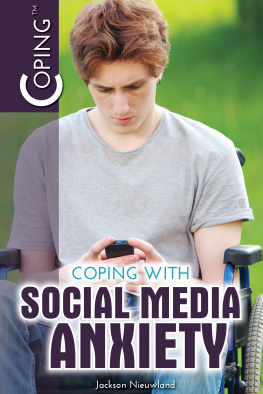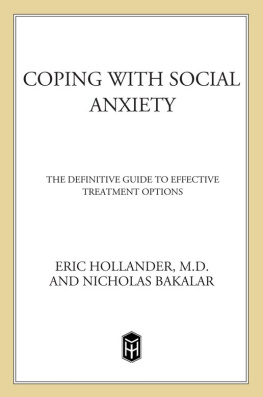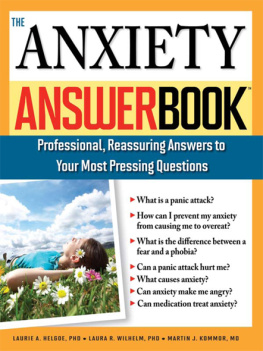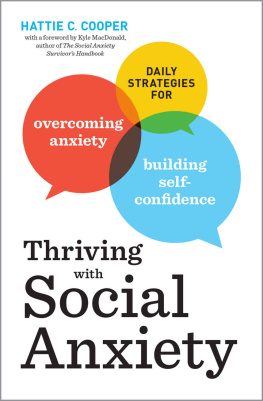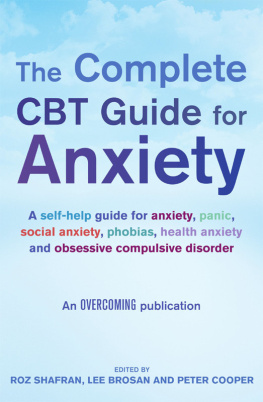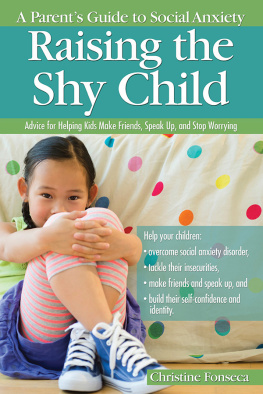Understanding Social Anxiety
A Recovery Guide for Sufferers, Family, and Friends
Vera Sonja Maass

Copyright 2017 by Vera Sonja Maass
All rights reserved. No part of this publication may be reproduced, stored in a retrieval system, or transmitted, in any form or by any means, electronic, mechanical, photocopying, recording, or otherwise, except for the inclusion of brief quotations in a review, without prior permission in writing from the publisher.
Library of Congress Cataloging-in-Publication Data
Names: Maass, Vera Sonja, author.
Title: Understanding social anxiety : a recovery guide for sufferers, family, and friends / Vera Sonja Maass.
Description: Santa Barbara, California : Praeger, an Imprint of ABC-CLIO, LLC, [2017] | Includes bibliographical references and index.
Identifiers: LCCN 2016040338 (print) | LCCN 2016042933 (ebook) | ISBN 9781440841958 (hardcopy : alk. paper) | ISBN 9781440841965 (ebook)
Subjects: LCSH: Social phobiaHandbooks, manuals, etc. | AnxietyHandbooks, manuals, etc.
Classification: LCC RC552.S62 M33 2017 (print) | LCC RC552.S62 (ebook) | DDC 616.85/22dc23
LC record available at https://lccn.loc.gov/2016040338
ISBN: 978-1-4408-4195-8
EISBN: 978-1-4408-4196-5
21 20 19 18 17 1 2 3 4 5
This book is also available as an eBook.
Praeger
An Imprint of ABC-CLIO, LLC
ABC-CLIO, LLC
130 Cremona Drive, P.O. Box 1911
Santa Barbara, California 93116-1911
www.abc-clio.com
This book is printed on acid-free paper 
Manufactured in the United States of America
This book discusses treatments (including types of medication and mental health therapies), diagnostic tests for various symptoms and mental health disorders, and organizations. The author has made every effort to present accurate and up-to-date information. However, the information in this book is not intended to recommend or endorse particular treatments or organizations, or substitute for the care or medical advice of a qualified health professional, or be used to alter any medical therapy without a medical doctors advice. Specific situations may require specific therapeutic approaches not included in this book. For those reasons, we recommend that readers follow the advice of qualified health care professionals directly involved in their care. Readers who suspect they may have specific medical problems should consult a physician about any suggestions made in this book.
Contents
Preface
Although social anxiety disorder is currently receiving increased public attention, it is by no means a new problem, as is outlined in this book. Sadly, the rekindled attention is due to an increase of occurrence of the problem and the growing use of prescription drugs for italong with increased medication abuse and deaths due to overdose.
When, why, and how does social anxiety develop, and who is prone to suffer from it? Experts during the decade of anxiety in the 1980s searched for the answers. Arriving at a lack of self-esteem for an answer, they made valiant efforts to correct for this apparent shortage. Self-esteem was considered to be the solution for social problems. However, as is discussed in this book, the forces operating within the disorder of social anxiety are complex and complicated, requiring exploration deeply beyond the surface.
Many research workers agree that there is no single factor that determines the development of social anxiety; rather there seems to be a multitude of factors. Other experts in the field point to general vulnerabilities as the core of anxiety disorders.
Some experts believe that the roots of social anxiety are to be found in ones childhood, and while this seems to be true in many cases, having passed the childhood years does not mean that one will not develop the difficulty later in response to future events and experiences. There is no vaccination available to prevent its occurrence, but changes in ones brain activities when forming beliefs and developing thoughts regarding certain disturbing situations could lead to resolution and relief.
The authors past training with Albert Ellis, PhD, founder of Rational Emotive Behavior Therapy (REBT), and Maxie C. Maultsby Jr., MD, founder of Rational Behavior Therapy (RBT), has provided an appreciation for research and theory-building but also for the power of peoples thoughts and beliefs and the impact those thoughts and deeply entrenched beliefs have on peoples quality of life, their happiness, and their distress.
As can be observed from the case histories described in this book, patience and intense focus are required from both the client and the therapist as they delve deeply below the surface in their efforts to reach the core of the impairment and explore the implications for achieving relief and healing.
Acknowledgments
My special thanks are deserved by the brave individuals in the community at large who so graciously consented to disclose their life stories and past experiences to the general public. They were generous with their time and the information they shared; it is greatly appreciated.
My appreciation for the clients who allowed me to incorporate their case histories is limitless. Their stories have become a significant part of this book. For reasons of confidentiality their names have been changed, and some of their circumstances have been disguised. Some of their stories have been combined to form composite characters. Although I cannot disclose their identities, they know who they are, and they know the impact of their generosity on this book.
My deepest gratitude belongs to Debbie Carvalko, Senior Acquisitions Editor, Psychology and Health, not only for her expert professional guidance but for the caring recognition that I needed work to help me adjust to and heal over the biggest loss in my life. Debbie, I treasure the experience of working with you on our previous books, and I am deeply indebted to you for the coming to life of this book.
Finally, I want to dedicate this book to the memory of my husband, H. Gordon Featherstonaugh, PhD, who had so much looked forward to seeing this books completion. Sadly, my psychologist-colleague and life partners wish was not granted.
CHAPTER ONE
Overview
It seems so ridiculous, but the whole idea of going to church suddenly frightens me. This started shortly after my divorce. Last Sunday, as we were getting ready for church, the anxiety became so strong, like something awful was going to happen. My heart was racing, my hands became clammy with cold sweat, and I had difficulty breathing. My oldest son saw me tremble and asked me if I was sick. We decided not to go to church.
Those were the words spoken in a barely audible voice by Gina, a 34-year-old woman, divorced mother of two sons, in her first therapy session. At the end of the session, the preliminary diagnosis in her chart read social anxiety disorder.
According to the current edition of The Diagnostic and Statistical Manual of Mental Disorders ( DSM-5 ), the essential feature of social anxiety disorder is a marked, or intense, fear or anxiety of social situations in which the individual may be scrutinized by others. And when exposed to such social situations, the individual fears that he or she will be negatively evaluated. The prevalence estimate for social anxiety disorder in the United States is around 7 percent. In general, rates of the disorder have been higher for females than for males. This gender difference tends to be more pronounced in adolescents and young adults. The median age at onset of social anxiety disorder in the United States is 13 years old; about 75 percent of people with social anxiety experienced an initial onset between the ages of 8 and 15.
Next page

